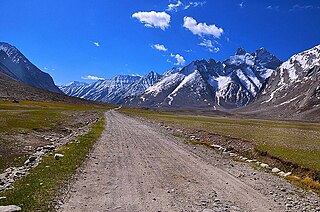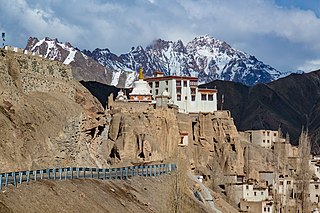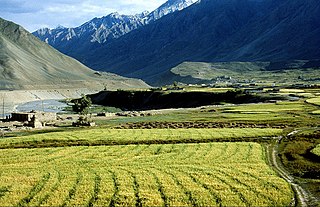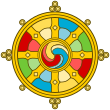
Zanskar or Zahar (locally) or Zangskar is a subdistrict or tehsil of the Kargil district, which lies in the eastern half of the Indian union territory of Ladakh. The administrative centre is Padum. Zanskar, together with the neighbouring region of Ladakh, was briefly a part of the kingdom of Guge in Western Tibet.

Padum is named after Padmasambhava. It is the only town and administrative centre in Zanskar. It was historically one of the two main capitals of the Zanskar Kingdom, the other being Zangla. It is 240 km away via the link road from Kargil town.

The Suru valley is a valley in the union territory of Ladakh in India. It is drained by the Suru River, a powerful tributary of the Indus River. The valley's most significant town is Kargil.

Lamayuru or Yuru Monastery is a Tibetan Buddhist monastery in Lamayouro, Leh district, Ladakh, India. It is situated on the Srinagar-Leh highway 15 kilometres (9.3 mi) east of the Fotu La at a height of 3,510 metres (11,520 ft).

8th Agya Hotogtu is one of the most prominent Buddhist teachers and lamas to have left Tibet. At age two, Arjia Rinpoche was recognized by Choekyi Gyaltsen, 10th Panchen Lama as the 20th Arjia Danpei Gyaltsen, the reincarnation of Je Tsongkhapa's father, Lumbum Ghe, the throne holder and abbot of Kumbum Monastery. He has trained with lineage teachers, such as the 14th Dalai Lama, the 10th Panchen Lama, and Gyayak Rinpoche—from whom he received many sacred teachings and ritual instructions.

Thikse Gompa or Thikse Monastery is a gompa affiliated with the Gelug sect of Tibetan Buddhism. It is located on top of a hill in Thiksey approximately 19 kilometres (12 mi) east of Leh in Ladakh, India. It is noted for its resemblance to the Potala Palace in Lhasa, Tibet and is the largest gompa in central Ladakh, notably containing a separate set of buildings for female renunciates that has been the source of significant recent building and reorganisation.

Khaltse or Khalsi is the headquarter of eponymous Subdivision, block and tehsil in the Leh district of Ladakh, India. It is located 337 km from Srinagar on the old main road to Leh, where it crossed the Indus over an iron bridge. Much of its importance is because it is the place where the road from Kashmir debouches into the Indus Valley. Close by are the remains of an old fortified customs house.

Lochen Rinchen Zangpo (958–1055), also known as Mahaguru, was a principal lotsawa or translator of Sanskrit Buddhist texts into Tibetan during the second diffusion of Buddhism in Tibet. He was a student of the famous Indian master, Atisha. His associates included (Locheng) Legpai Sherab. Zangpo's disciple Guge Kyithangpa Yeshepal wrote Zangpo's biography. He is said to have built over one hundred monasteries in Western Tibet, including the famous Tabo Monastery in Spiti, Himachal Pradesh, and Poo in Kinnaur.

Phugtal Monastery or Phugtal Gompa is a Buddhist monastery located in the remote Lungnak Valley in south-eastern Zanskar, in the autonomous Himalayan region of Ladakh, in Northern India. It is one of the only Buddhist monasteries in Ladakh that can still be reached only by foot. Supplies to the monastery are brought on horses, donkeys, and mules in the warmer months, and in the frozen winters, they are transported through the frozen Zanskar River. A road is expected to be built up to the monastery, however, for now, it is a day's walk from Village Cha or Village Khangsaar, the end of the road leading from Padum. The Phugtal monastery was Solar powered up in 2016 with a team of Global Himalayan Expedition (GHE) members.

Karsha Monastery or Karsha Gompa is a Buddhist monastery in the Padum Valley of the Zanskar region of the state of Jammu and Kashmir in northern India. The Doda River flows past the monastery from its source at the Drang Drung glacier of the Pensi La. It was founded by the translator, Phagspa Shesrab. The monastery, also known by the name "Karsha Chamspaling’, was founded by Phagspa Shesrab, under the Gelugpa Order or the Yellow Hat Order.

Tabo Monastery is located in the Tabo village of Spiti Valley, Himachal Pradesh, northern India. It was founded in 996 CE in the Tibetan year of the Fire Ape by the Tibetan Buddhist lotsawa (translator) Rinchen Zangpo, on behalf of the king of western Himalayan Kingdom of Guge, Yeshe-Ö. Tabo is noted for being the oldest continuously operating Buddhist enclave in both India and the Himalayas. A large number of frescoes displayed on its walls depict tales from the Buddhist pantheon. There are many priceless collections of thankas, manuscripts, well-preserved statues, frescos and extensive murals which cover almost every wall. The monastery is in need of refurbishing as the wooden structures are aging and the thanka scroll paintings are fading. After the earthquake of 1975, the monastery was rebuilt, and in 1983 a new Du-kang or Assembly Hall was constructed. It is here that the 14th Dalai Lama held the Kalachakra ceremonies in 1983 and 1996. The monastery is protected by the Archaeological Survey of India (ASI) as a national historic treasure of India.

Likir Monastery or Likir Gompa (Klud-kyil) is a Buddhist monastery in Ladakh, Northern India. It is located at 3700m elevation, approximately 52 kilometres (32 mi) in the west of Leh. It is picturesquely situated on a little hill in the valley, in Likir village near the Indus River about 9.5 kilometres (5.9 mi) north of the Srinigar to Leh highway. It belongs to the Gelugpa sect of Tibetan Buddhism and was established in 1065 by Lama Duwang Chosje, under the command of the fifth king of Ladakh, Lhachen Gyalpo (Lha-chen-rgyal-po).

Diskit Monastery also known as Deskit Gompa or Diskit Gompa is the oldest and largest Buddhist monastery (gompa) in the Nubra Valley of Ladakh, northern India.

Mulbekh Monastery or Mulbekh Gompa is said to consist of two gompas, one Drukpa and one Gelugpa Buddhist monastery in Kargil, Ladakh of the state Jammu and Kashmir in northern India. Names of the monasteries are Serdung Gompa and Rgaldan-se Gompa of Drukpa and Gelugpa sect respectively. Recently the Rgaldan-se Gompa was reconstructed in 2016. It also consist a Lhakhang known as Nyima Lhakhang, it is the oldest section of the Mulbekh Monastery. It is believed to be built around 800 year ago by the students of great Tibetan scholar Lotsawa Rinchen Zangpo, it is clear with the style of painting.
Sani Monastery, Sa-ni-[tshog], is located next to the village of Sani where the Stod Valley broadens into the central plain of Zanskar in Jammu and Kashmir in northern India. It is about 6 km to the northwest of the regional centre of Padum, a gentle two-hour walk. Like Dzongkhul Monastery, it belongs to the Drukpa Kargyu school of Tibetan Buddhism, and is the only one of this order in Zanskar which has nuns. It is thought to be the oldest religious site in the whole region of Ladakh and Zanskar.

Stongdey Monastery, often written Stongde, Stongday, Tonday or Thonde, is a flourishing Buddhist monastery in Zanskar, Jammu and Kashmir, northern India, approximately 18 km north of Padum, on the road to Zangla, India.

Alchi Monastery or Alchi Gompa is a Buddhist monastery, known more as a monastic complex (chos-'khor) of temples in Alchi village in the Leh District, of the Indian state under the Ladakh Autonomous Hill Development Council of Jammu and Kashmir. The complex comprises four separate settlements in the Alchi village in the lower Ladakh region with monuments dated to different periods. Of these four hamlets, Alchi monastery is said to be the oldest and most famous. It is administered by the Likir Monastery.

Buddhism in the Indian state of Himachal Pradesh has been a long recorded practice. The spread of Buddhism in the region has occurred intermediately throughout its history. Starting in the 3rd century BCE, Buddhism was propagated by the Maurya Empire under the reign of Ashoka. The region would remain an important center for Buddhism under the Kushan Empire and its vassals. Over the centuries the following of Buddhism has greatly fluctuated. Yet by experiencing revivals and migrations, Buddhism continued to be rooted in the region, particularly in the Lahaul, Spiti and Kinnaur valleys.

Yeshe-Ö (spiritual names: Jangchub Yeshe-Ö, Byang Chub Ye shes' Od, Lha Bla Ma, Hla Lama Yeshe O, Lalama Yixiwo, bKra shis mgon; also Dharmaraja was the first notable lama-king in Tibet. Born as Khor-re, he is better known as Lhachen Yeshe-Ö, his spiritual name.
Jangsem Sherab Zangpo, also known as Jangsem Sherab Sangpo, (1395-1457) was a 15th-century Tibetan Buddhist monk and teacher, and one of the six contemporary disciples of Je Tsongkhapa, the founder of one of the newest school of Tibetan Buddhism, the Gelug school. He is crediting with establishing the famed Thikse Monastery and the remotely located Phugtal Monastery in Ladakh, in the North Indian state of Jammu and Kashmir.






















